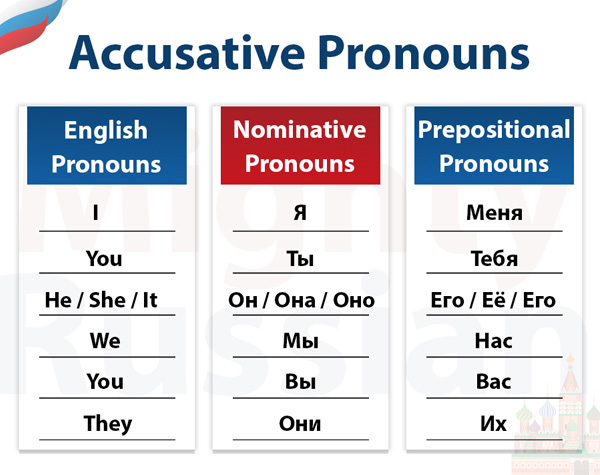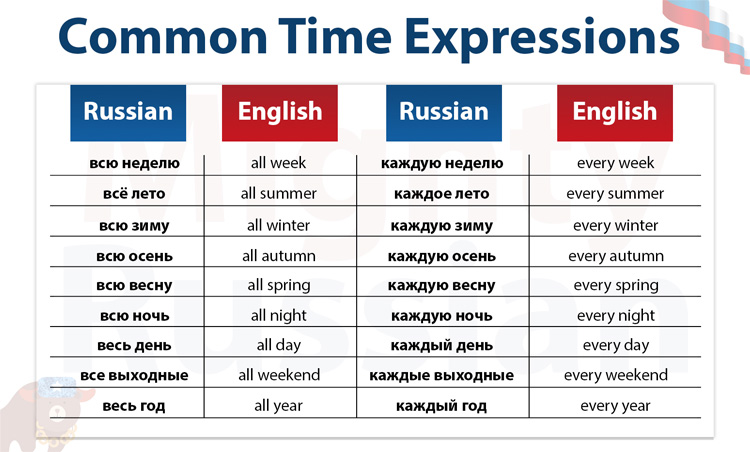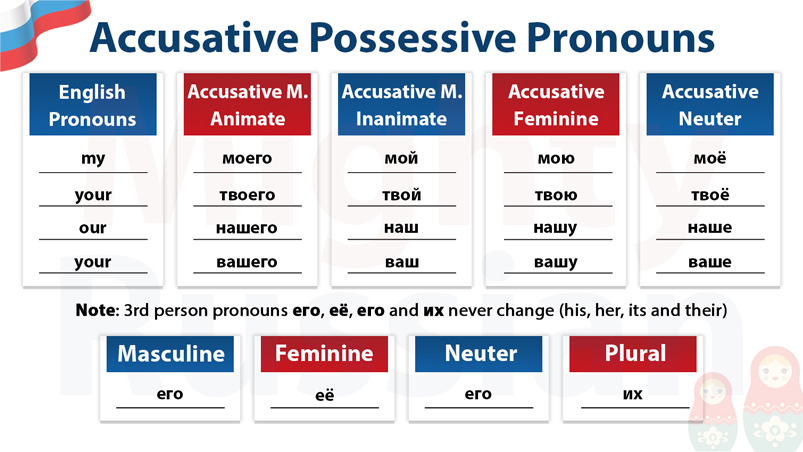The Accusative Case in Russian
The Accusative Case is one of the first things every student has to learn.
Luckily, it’s also very straightforward and easy to understand.
In this lesson, I will explain everything you need to know about the Accusative.
To make things easier, I will divide the lesson into 3 parts:
1) Nouns in the Accusative Case;
2) When and how to use the Accusative Case;
3) Adjectives in the Accusative Case;
4) Possessive Pronouns in the Accusative Case.
Note that the above titles in blue have links. If there is any subject you would like to study first, you can just click on it and go straight to that part of the lesson.
In this lesson, we won’t talk about plural nouns and adjectives in the Accusative Case because we already have a complete lesson about this subject here at Mighty Russian.
If you already know how to use the Accusative Case in the singular, you can go straight to the next lesson:
- Accusative Case in the Plural
Nouns in the Accusative Case
All you have to do in order to use the Accusative Case is change the ending of the noun.
Declining (changing) the noun is normally the scariest part for learners because of all the rules they have to memorize.
But you shouldn’t be afraid. The Accusative Case is much simpler than the other cases.
In many situations, you won’t even have to make any changes to the noun.
And when you do have to make changes, the vast majority of nouns will fall into 4 common patterns.
Let’s start by taking a look at each of the main patterns.
You will notice that the changes you will make to the noun depend a lot on its gender.
If you are not familiar with the concept of gender in the Russian language, you can check out our complete lesson about this subject clicking here.
1) When a noun ends in “А”, replace “А” with “У”:
машина – машину
сестра – сестру
мама – маму
дедушка – дедушку
2) When a noun ends in “Я”, replace “Я” with “Ю”:
тётя – тётю
дядя – дядю
семья – семью
Настя – Настю
3) When an animate masculine noun ends in a consonant, add the letter “А”:
(Animate nouns denote human beings and animals.)
брат – брата
кот – кота
друг – друга
студент – студента
4) When an animate masculine noun ends in “Ь” or “Й”, replace the last letter with “Я”:
учитель – учителя
конь – коня
герой – героя
Андрей – Андрея
Besides these endings, you will also need to know Accusative Pronouns. You will need them when the context is clear and you don’t want to repeat the noun.
Now, let’s learn when to use the Accusative Case.
When to use the Accusative Case in Russian
The Accusative Case is used in three main situations:
- to identify the direct object in a sentence;
- after certain prepositions;
- to denote time in non-prepositional phrases.
Let’s take a look at each of these situations one by one.
01) The Direct Object
Whenever there is a direct object in a sentence, you need to use the Accusative Case.
(If you already know how to identify the direct object of a sentence, you can skip the following explanation and go straight to the examples).
The direct object is a thing or a person that is directly affected by the action of the verb.
In other words, it’s a thing or a person that suffers the action.
Let’s take a look at a simple sentence:
Мэри увидела девушку (Mary saw the girl)
In this sentence, we have:
- “Mary / Мэри”, which is the subject, or the doer of the action;
- “saw / увидела”, which is the verb, or the action of the sentence;
- And “the girl / девушку”, which is the direct object, or the sufferer of the action.
So, in Russian, “девушку” is in the Accusative Case, as it is the direct object of the sentence.
Other examples:
Я вижу его (I see him)
Он видит меня (He sees me)
In this case, “его / him” and “меня / me” are the sufferer of the action. That’s why they both are in the Accusative Case.
A good way to identify the direct object in a sentence is to think about the questions of “кого / whom” or “что / what”.
Most of the time, you will answer these two questions using the Accusative Case.
For example:
Что видит Мэри? (What does Mary see?)
Мэри видит футболку (She sees a T-shirt)
Кого он видит? (Who(m) does he see?)
Он видит меня (He sees me)
Simple, right?
I hope everything got clear, but if you have any questions, feel free to leave them in the comments section.
Let’s move on to the next situation!
02) Accusative Prepositions
Think of Accusative Prepositions simply as prepositions that are followed by the Accusative Case.
The Accusative Prepositions are:
в = to / into (direction)
на = to / onto (direction)
под = under (direction)
за = for / behind (direction)
про = about
через = through
As you can see, there are only six Accusative Prepositions. Just write them down and you will easily memorize them as you practice.
(With the prepositions “В”, “НА” and “ПОД”, you will use the accusative case to talk about direction, not location).
Let’s take a look at some examples:
Маша идёт в школу (Masha is going to school)
Поставь велосипед за дом (Put the bicycle behind the house)
Мы говорим про маму (We are talking about Mom)
Note that the first two examples deal with direction.
3) Time Phrases in the Accusative Case
The accusative case can also denote time in phrases that don’t involve prepositions.
For example:
Всю неделю шёл снег (It snowed all week)
Всё лето было жарко (It was hot all summer)
Он ходит в спортзал каждую неделю (He goes to the gym every week)
In this situation, there aren’t any clear-cut rules to follow. You just have to memorize these expressions.
Two common patterns involve the words “всё” and “каждый”.
This may seem hard but you don’t have to memorize all of them at once. Try to do it bit by bit as you practice. Besides that, many of the expressions coincide with the Nominative Case, which makes things much easier.
Here is a table with some very common expressions:
Don’t hesitate to download and print out this picture. It will sure be helpful for you.
And those are all the situations in which you will use the Accusative Case.
Now let’s talk about adjectives!
How to put Adjectives into the Accusative Case
In the Accusative Case, the main change happens to adjectives used with feminine nouns.
All adjectives that are used with feminine nouns take the endings “УЮ” or “ЮЮ”.
Let’s take a look at when you should use each of them.
1) If the adjective ends in “АЯ”, replace “АЯ” with “УЮ”.
For example:
красивая девушка – красивую девушку (a beautiful girl)
новая машина – новую машину (a new car)
старая картина – старую картину (an old picture)
добрая женщина – добрую женщину (a kind woman)
2) If the adjective ends in “ЯЯ“, replace “ЯЯ“ with “ЮЮ”.
For example:
зимняя ночь – зимнюю ночь (a winter night)
синяя футболка – синюю футболку (a blue T-shirt)
ранняя весна – раннюю весну (early spring)
With the rest of the genders, the accusative form depends on whether the adjective is used with animate or inanimate nouns.
Animate nouns refer to human beings and animals (man, doctor, woman, dog, etc.)
Inanimate nouns refer to objects and abstract concepts that are not alive (table, love, money, chair, etc.)
When adjectives are used with inanimate nouns in the Accusative Case, they are identical to the Nominative Case (except for feminine nouns which we have already learnt).
I will go over the main endings of adjectives in the Nominative Case and give you some examples, but I won’t go into detail about their usage in this lesson.
If you don’t know yet when and how to use the Nominative Case, you can check out our complete lesson about it clicking here.
Adjectives used with masculine nouns can have 3 endings.
1) Most adjectives end in “ЫЙ“:
новый дом (a new house)
старый стол (an old table)
чёрный телефон (a black cellphone)
2) Some of them end in “ИЙ“:
хороший магазин (a good store)
русский роман (a Russian novel)
маленький стул (a small chair)
3) And a few of them end in “ОЙ”:
плохой день (a bad day)
большой парк (a big park)
дорогой подарок (an expensive gift)
Adjectives used with neuter nouns can have 2 endings.
1) Most adjectives end in “ОЕ“:
красное яблоко (a red apple)
длинное письмо (a long letter)
тёплое море (a warm sea)
2) Some of them end in “ЕЕ“:
раннее утро (early morning)
хорошее яблоко (a good apple)
летнее платье (a summer dress)
Now, the Accusative Case of adjectives that are used with animate masculine nouns is identical to the Genitive Case.
In this lesson, I won’t explain how to use Genitive Case because we already have a complete lesson about it here at Mighty Russian.
If you don’t know yet when and how to use the Genitive Case, you can check out our lesson about it clicking here.
1) When an adjective ends in “ЫЙ” and “ОЙ”, replace these endings with “ОГО”:
новый студент – нового студента (a new student)
плохой человек – плохого человека (a bad person)
молодой человек – молодого человека (a young man)
2) When an adjective ends in “ИЙ”, replace “ИЙ” with “ЕГО”:
хороший друг – хорошего друга (a good friend)
Note that when the last consonant in the adjective is “К” or “Х”, it takes the ending “ОГО” instead of “ЕГО”:
русский человек – русского человека (a Russian person)
маленький ребёнок – маленького ребёнка (a small child)
POSSESSIVE PRONOUNS IN THE ACCUSATIVE CASE
The Accusative Possessive Pronouns are:
You will use these Possessive Pronouns in the same situations that you learnt about earlier.
For example:
Мой брат любит мою машину (My brother loves my car)
Я видел твою маму в супермаркете (I saw your mother at the supermarket)
Они продали свою квартиру (They sold their apartment)
And that’s all.
Now you know exactly when and how to use the Accusative Case.
Don’t forget to check out our complete lesson about the Accusative Plural. It will also be very useful for you.
I hope everything got clear, but if you have any questions, just leave them in the comment section below.
I will be very happy to help you!















Привет дарагоя Настя,
На самом деле никто поверить что я выучил по-русски на инстаграме с вашего помощью.
Я всегда блогодарею вас.
Вы супер.🙏🙏